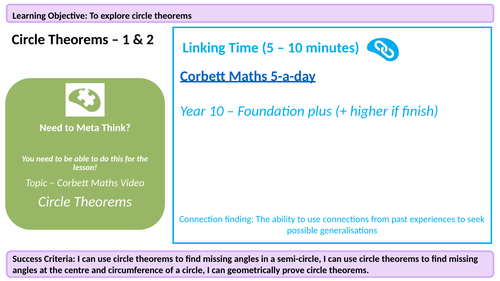





Lesson Contents: Circle Theorems
Download Includes:
- A comprehensive PowerPoint lesson designed for interactive use with a clicker, mouse, or keyboard to navigate through animations and display fully animated and worked solutions.
Topic of Study: Circle Theorems
Differentiated Objectives:
-
Developing Learners will be able to:
- Apply circle theorems to find missing angles.
-
Secure Learners will be able to:
- Justify, with reason, the circle theorems they apply to find missing angles.
-
Excelling Learners will be able to:
- Solve unfamiliar problems using circle theorems.
Main Components:
The main segment of the lesson unfolds with a step-by-step approach:
- Walked through examples demonstrate the application of circle theorems.
- Practice questions on accompanying worksheets progress from basic queries on the just-introduced theorem to exam-style questions utilizing each of the theorems previously introduced.
- All solutions are provided directly within the PowerPoint presentation for easy reference.
Circle Theorem Statements:
-
Angles in the Same Segment:
- Angles in the same segment of a circle are equal.
-
Opposite Angles in a Cyclic Quadrilateral:
- Opposite angles in a cyclic quadrilateral add up to 180 degrees.
-
Angle at the Center:
- The angle at the center of a circle is twice any angle at the circumference subtended by the same arc.
-
Angles in a Semi-Circle:
- Angles formed in a semi-circle are always right angles.
-
Alternate Segment Theorem:
- An angle between a chord and a tangent is equal to the angle in the alternate segment.
-
Tangent-Radius Perpendicularity:
- A radius at the point of tangency to a circle is perpendicular to the tangent.
-
*Cyclic Quadrilateral Diagonals:
- The diagonals of a cyclic quadrilateral bisect each other at right angles.
-
Chord Bisection:
- A chord that passes through the center of a circle is bisected by the circle into two equal parts.
This lesson is structured to empower learners at various levels, ensuring a comprehensive understanding of circle theorems and proficiency in their application across different scenarios.
Something went wrong, please try again later.
This resource hasn't been reviewed yet
To ensure quality for our reviews, only customers who have purchased this resource can review it
Report this resourceto let us know if it violates our terms and conditions.
Our customer service team will review your report and will be in touch.